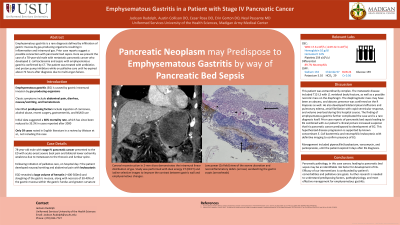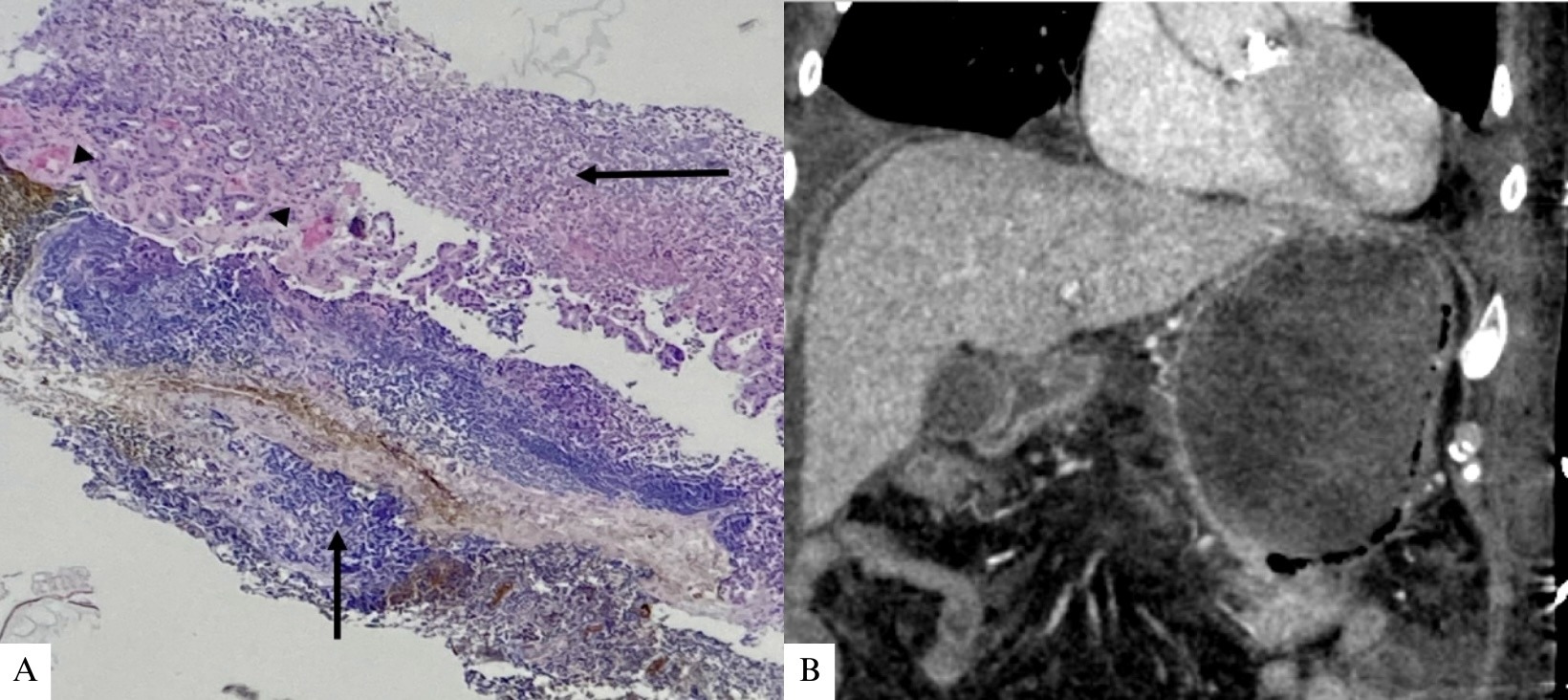Tuesday Poster Session
Category: Stomach
P4214 - Emphysematous Gastritis in a Patient With Stage IV Pancreatic Cancer
Tuesday, October 24, 2023
10:30 AM - 4:00 PM PT
Location: Exhibit Hall

Has Audio

Jackson E. Rudolph, BS
Uniformed Services University of the Health Sciences
Joint Base Lewis-McChord, WA
Presenting Author(s)
Jackson E. Rudolph, BS1, Austin Collison, DO2, Cesar Rosa, DO2, Erin E. Gorton, DO2, Neal Passante, MD2
1Uniformed Services University of the Health Sciences, Joint Base Lewis-McChord, WA; 2Madigan Army Medical Center, Joint Base Lewis-McChord, WA
Introduction: Emphysematous gastritis (EG) results from gastric intramural invasion of gas-producing organisms leading to gastric inflammation. The condition classically presents with abdominal pain, diarrhea, vomiting, and hematemesis. Although the pathophysiology of EG remains unclear, predisposing factors have been identified including ingestion of corrosives, alcohol abuse, recent surgery, gastroenteritis, and NSAID use. We present an unusual case of EG in a patient undergoing palliative care for pancreatic cancer.
Case Description/Methods: A 78-year-old male with stage IV pancreatic cancer presented to the emergency department with acute-onset severe back pain and bilateral lower extremity weakness due to metastases to the thoracic and lumbar spine. Radiation oncology was consulted for initiation of palliative radiation therapy to the lumbar spine.
On hospital day 7 the patient developed nausea and vomiting with an interval development of leukocytosis to 17.6 x10^9/L. Infectious workup was unremarkable. A CT abdomen/pelvis revealed emphysematous gastritis. Infectious disease and gastroenterology were consulted. Esophagogastroduodenoscopy (EGD) revealed a large volume of hematin (~400-500mL) and sloughing of the gastric mucosa, along with necrosis of 30-40% of the gastric mucosa within the gastric fundus and greater curvature. Biopsies were non-specific, showing ulceration and reactive changes with no malignancy, dysplasia, or intestinal metaplasia.
Supportive management with bowel rest, proton pump inhibitor, empiric antibiotics and intravenous fluids were started. Unfortunately, the patient passed away due to complications from sepsis despite cross-sectional imaging showing improvement in EG.
Discussion: Emphysematous gastritis has a mortality rate of up to 60%. In the absence of common risk factors identified for EG, this case could be an example of pancreatic adenocarcinoma predisposing to EG. A 2022 case report by Nunna et al. described EG secondary to pancreatitis with cholelithiasis that may have been precipitated by sepsis in the pancreatic bed. We posit that the pancreatic neoplasm predisposed our patient to develop pancreatic bed sepsis, evidenced by leukocytosis, tachycardia, and emesis, introducing infiltrative gas-producing bacteria to the gastric mucosa. Conservative management with PPI and antibiotics was appropriate for our patient on palliative care for metastatic cancer.

Disclosures:
Jackson E. Rudolph, BS1, Austin Collison, DO2, Cesar Rosa, DO2, Erin E. Gorton, DO2, Neal Passante, MD2. P4214 - Emphysematous Gastritis in a Patient With Stage IV Pancreatic Cancer, ACG 2023 Annual Scientific Meeting Abstracts. Vancouver, BC, Canada: American College of Gastroenterology.
1Uniformed Services University of the Health Sciences, Joint Base Lewis-McChord, WA; 2Madigan Army Medical Center, Joint Base Lewis-McChord, WA
Introduction: Emphysematous gastritis (EG) results from gastric intramural invasion of gas-producing organisms leading to gastric inflammation. The condition classically presents with abdominal pain, diarrhea, vomiting, and hematemesis. Although the pathophysiology of EG remains unclear, predisposing factors have been identified including ingestion of corrosives, alcohol abuse, recent surgery, gastroenteritis, and NSAID use. We present an unusual case of EG in a patient undergoing palliative care for pancreatic cancer.
Case Description/Methods: A 78-year-old male with stage IV pancreatic cancer presented to the emergency department with acute-onset severe back pain and bilateral lower extremity weakness due to metastases to the thoracic and lumbar spine. Radiation oncology was consulted for initiation of palliative radiation therapy to the lumbar spine.
On hospital day 7 the patient developed nausea and vomiting with an interval development of leukocytosis to 17.6 x10^9/L. Infectious workup was unremarkable. A CT abdomen/pelvis revealed emphysematous gastritis. Infectious disease and gastroenterology were consulted. Esophagogastroduodenoscopy (EGD) revealed a large volume of hematin (~400-500mL) and sloughing of the gastric mucosa, along with necrosis of 30-40% of the gastric mucosa within the gastric fundus and greater curvature. Biopsies were non-specific, showing ulceration and reactive changes with no malignancy, dysplasia, or intestinal metaplasia.
Supportive management with bowel rest, proton pump inhibitor, empiric antibiotics and intravenous fluids were started. Unfortunately, the patient passed away due to complications from sepsis despite cross-sectional imaging showing improvement in EG.
Discussion: Emphysematous gastritis has a mortality rate of up to 60%. In the absence of common risk factors identified for EG, this case could be an example of pancreatic adenocarcinoma predisposing to EG. A 2022 case report by Nunna et al. described EG secondary to pancreatitis with cholelithiasis that may have been precipitated by sepsis in the pancreatic bed. We posit that the pancreatic neoplasm predisposed our patient to develop pancreatic bed sepsis, evidenced by leukocytosis, tachycardia, and emesis, introducing infiltrative gas-producing bacteria to the gastric mucosa. Conservative management with PPI and antibiotics was appropriate for our patient on palliative care for metastatic cancer.

Figure: Figure 1: A. Low power (2x field) view of the severe ulceration and necroinflammatory debris (arrows) sandwiching the gastric crypts (arrowhead). B. Coronal reconstruction in 2-mm slices demonstrates the intramural linear distribution of gas. Study was performed with dual energy CT (DECT) and iodine selective images to improve the contrast between gastric wall and emphysematous changes.
Disclosures:
Jackson Rudolph indicated no relevant financial relationships.
Austin Collison indicated no relevant financial relationships.
Cesar Rosa indicated no relevant financial relationships.
Erin Gorton indicated no relevant financial relationships.
Neal Passante indicated no relevant financial relationships.
Jackson E. Rudolph, BS1, Austin Collison, DO2, Cesar Rosa, DO2, Erin E. Gorton, DO2, Neal Passante, MD2. P4214 - Emphysematous Gastritis in a Patient With Stage IV Pancreatic Cancer, ACG 2023 Annual Scientific Meeting Abstracts. Vancouver, BC, Canada: American College of Gastroenterology.

